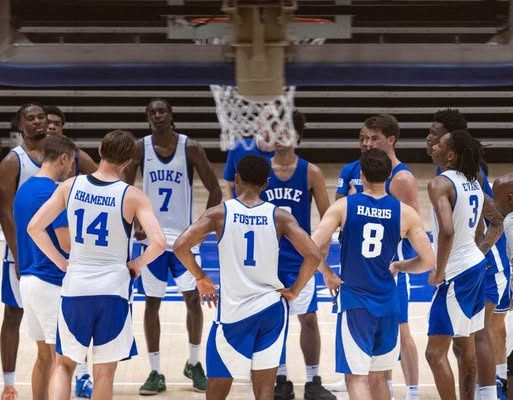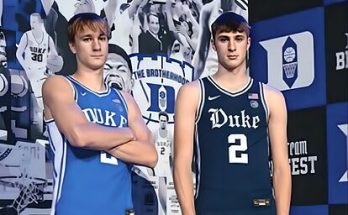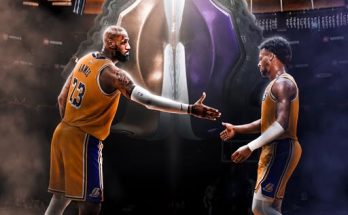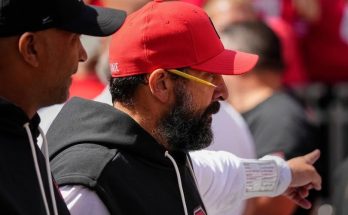The echoes of Cameron Indoor Stadium may be quiet during the summer, but inside the practice facility, the sweat tells a louder story. Duke basketball is back at it, and while the season is months away, the early glimpses from summer practices are already revealing what fans and insiders have long suspected — the Blue Devils are teetering on the edge of greatness. The roster is brimming with elite-level talent, high-profile recruits, experienced returnees, and versatile role players. On paper, this team has all the markings of a Final Four contender. Yet, as the drills unfold, one glaring flaw keeps resurfacing, casting a shadow over their lofty potential. If Duke can address this one issue, the ceiling is limitless. If not, another season of “what ifs” may be in store.
To understand how close this team is, you first have to understand just how much talent is gathered in Durham this offseason. The return of key players like Tyrese Proctor and Caleb Foster gives the Blue Devils a sense of continuity — a rare and valuable commodity in today’s college basketball landscape. Proctor, now entering his third season, has shown flashes of being a floor general with pro-caliber poise, a deadly mid-range game, and improved on-ball defense. Foster, meanwhile, is poised to take a leap, having bulked up in the weight room and tightened his handle, now looking more aggressive and assertive with the ball. Add to that the incoming freshman class headlined by top recruits like Cooper Flagg, Khaman Maluach, and Isaiah Evans, and you begin to see the makings of a juggernaut.
Flagg, especially, has generated the most buzz. The Maine native is the kind of transcendent player that doesn’t come around often. His ability to affect the game on both ends is staggering — shot blocking, floor spacing, vision, and intensity all bundled into a 6’9” frame with an engine that doesn’t stop. Coaches have already commented on how he elevates the pace and tone of every practice. But even Flagg, as complete as he is, can’t mask the team-wide issue that’s beginning to emerge.
That issue is mental toughness — not the kind that manifests in a huddle or during warmups, but the type that shows up when the lights are brightest and the game is on the line. It’s a habit, not a highlight. It’s how a team responds to adversity, to missed shots, to poor officiating, to runs by the opponent. And right now, Duke’s ability to withstand and push through those moments is inconsistent at best.
This isn’t just a theoretical concern. It’s been evident in closed scrimmages and even open media sessions. When the team is rolling, when the offense is humming and the defense is locked in, Duke looks unstoppable. There are stretches in practice where they rattle off a 12-0 run in minutes, fueled by suffocating ball pressure and elegant, unselfish ball movement. But when adversity hits — a turnover, a missed assignment, or a run by the second unit — cracks begin to show. The energy dips, communication stutters, and possessions begin to stall.
This lack of sustained grit has been the Achilles’ heel of previous Duke teams as well. In last year’s NCAA Tournament, the Blue Devils were bounced earlier than expected — not because they lacked talent, but because they struggled to execute when it mattered most. Late-game decisions, rushed shots, defensive lapses, and breakdowns in communication — all symptoms of a team that hadn’t fully developed the mental edge to close out big games. And while this year’s group is arguably more talented, the early signs suggest that they may fall into similar traps unless a cultural shift takes place.
It’s not that the players lack passion or work ethic. In fact, by all accounts, this summer’s practices have been among the most competitive and intense in recent memory. The coaching staff has been pushing them hard, mixing lineups, ramping up tempo, and forcing players to adapt on the fly. There’s a clear emphasis on conditioning and transition defense, a nod to the modern pace-and-space nature of the game. But grit isn’t built in a sprint. It’s forged in the habits formed when things get tough.
One drill that illustrated this point came during a recent session in which the team was tasked with executing under simulated high-pressure conditions. Shot clock winding down, full-court press, opposing team already on a 6-0 run. The goal was to execute cleanly and get a quality shot. The results were mixed. Proctor was poised, using his experience to direct traffic. Flagg showed flashes of brilliance, creating out of nothing. But some of the younger players panicked, over-dribbling, forcing contested threes, or committing costly turnovers. When mistakes occurred, the collective energy sagged rather than surged.
Head coach Jon Scheyer has been vocal about this being a point of emphasis. In interviews, he’s praised the team’s skill level and chemistry but has candidly acknowledged the need to develop more resilience. The word he uses often is “response.” How does this team respond when things go wrong? How do they weather a 10-0 run on the road with a hostile crowd? How do they respond to a poor shooting night or a bad whistle?
Scheyer, still relatively new in his tenure, is also evolving. His growth as a coach will play a key role in shaping this team’s identity. He’s experimenting more with his rotations, putting players in uncomfortable situations during practice to simulate pressure. He’s encouraging more vocal leadership from his veterans and even his freshmen. Flagg, while young, is emerging as a vocal force. But leadership in the huddle needs to translate to composure during crunch time, and that bridge is still under construction.
One potentially overlooked contributor to the toughness deficit is the composition of the roster itself. Many of Duke’s top players have been dominant their entire careers — AAU standouts, high school stars, Olympic team participants. They haven’t had to battle from behind often. Adversity, in many cases, is a new experience. Learning how to fail forward is a lesson that takes time — and often painful game situations — to fully absorb.
Another factor is the system. Duke’s offense has a tendency to become stagnant when the first or second action is stifled. When the scripted plays break down, the team sometimes struggles to generate rhythm. That’s where teams like UConn or Houston, who have embodied mental toughness and grit, shine — they can win ugly. They can scrap and claw and beat you with second-chance points and gritty defensive stops. For Duke to reach that level, they have to get comfortable with discomfort.
There is hope, though. The ingredients are all there. Maluach, a 7-footer with remarkable agility, could anchor the interior in ways that allow Duke to dominate the paint on both ends. Jared McCain’s shot-making and competitiveness are contagious. Mark Mitchell’s length and ability to guard multiple positions give the team tremendous flexibility. If those players can rally behind a common identity — one that prioritizes toughness as much as talent — this team can be special.
It also comes down to consistency. One good week of practice isn’t enough. The culture of resilience has to be built brick by brick, every day. That means every loose ball matters. Every closeout. Every box out. It’s the unsexy parts of the game that separate the elite from the merely talented. And right now, Duke is straddling that line.
Come November, the real tests will begin. The non-conference schedule will offer early opportunities to showcase just how much this group has grown. Games against top-tier opponents will force them to respond in real time to adversity. The ACC, as always, will be unforgiving. And then there’s March, where every possession counts and the mentally tough teams are the ones that survive.



